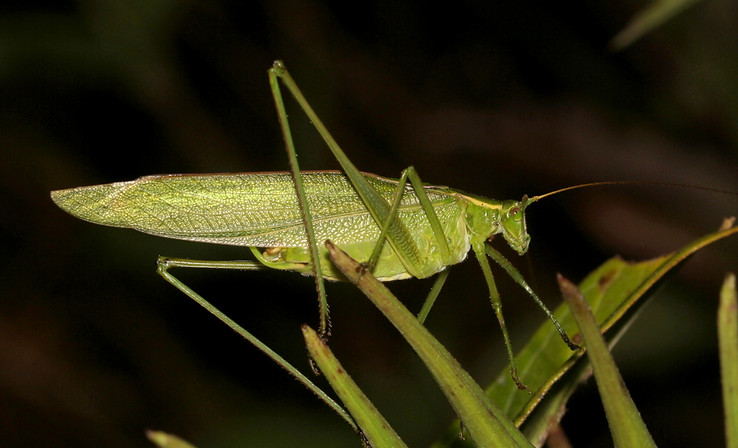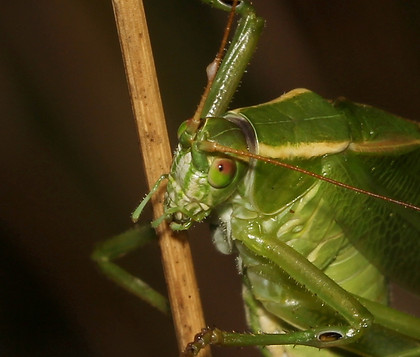Texas Bush Katydid

Texas Bush Katydid (Scudderia texensis)
Occurrence
Common
Habitat
Meadows, wetlands.
Range
All counties in our region.
Physical description
A little larger than the other Scudderia bush katydids. They are more autumnal in coloration, being a slightly darker green with bronze highlights. Their legs have reddish accents and there is a red edge to the tops of their wings.There are also white accents on their faces.




Male's tail plate. The female's ovipositor curves more sharply upward than the Curve-tailed Bush Katydid
Song:
The Texas Bush Katydid, like the Broad-winged Bush Katydid, has a day song and a night song. The night song has a couple of variations, but its bouncy, dance-like rhythms are faster than the other bush katydids: it’s approximately a fast “chi-chi-chi-chi-chi-chit”. The day song sounds like a very brief drum roll that is generally an extremely fast “chi-chi-chit!” - shorter than the “drum roll” of the Broad-winged Bush Katydid. The night songs are sometimes sung during the afternoon as well but are much more common after dark.

Adult season
The first or second week of August into October.
General description and context
Texas Bush Katydids don’t hesitate to sing their day song in the afternoon but they will usually be difficult to find. They may be down in the leaves of meadow vegetation, but they occasionally can be found right on top of the flowers. Like other Scudderia, they are strong fliers and will cover considerable distances when they decide you’ve finally gotten too close. If you are able to coax one onto your hand, it will often stay for a while and allow to admire its size and beauty.

Similar species
Other Scudderia katydids are somewhat similar, but the alternate possibility to consider would be the Curve-tailed Bush Katydid. Curve-taileds are common in the same habitats as the Texas, but they are a bit smaller and greener except for the reddish-pink on the backs of their long back legs. The tail plates and ovipositors will be a bit different; the Texas female’s ovipositor has a sharper upward bend than the curve of the Curve-tailed. However, you will need photos or the opportunity for very close observation to obtain that level of detail.

Female Texas Bush Katydid - sharp angle of her ovipositor is visible.
Remember that the Curve-tailed sings a slower song of two, three or four “tsits” while the Texas sings the very short, fast drum roll during the day and the fast “chi-chi-chi-chi-chi-chit” at night.
Field observation
This katydid species seems to have a preference for white asters over Ohio’s ever-present goldenrod. Once I made the mistake of placing a male on goldenrod after he’d been sitting on my hand. He loudly and indignantly made some “chit-chits!” at me each time I tried to put him in the goldenrod. When it occurred to me that he probably preferred small, white asters, he was perfectly satisfied.

Songs of Insects:
http://songsofinsects.com/katydids/texas-bush-katydid
Singing Insects of North America:
http://www.entnemdept.ufl.edu/walker/buzz/062a.htm
Nature Inquiries
https://natureinquiries.wordpress.com/2015/04/07/sound-ideas-texas-bush-katydid